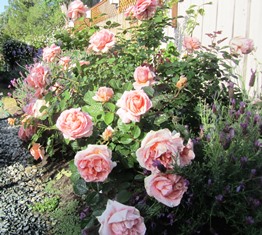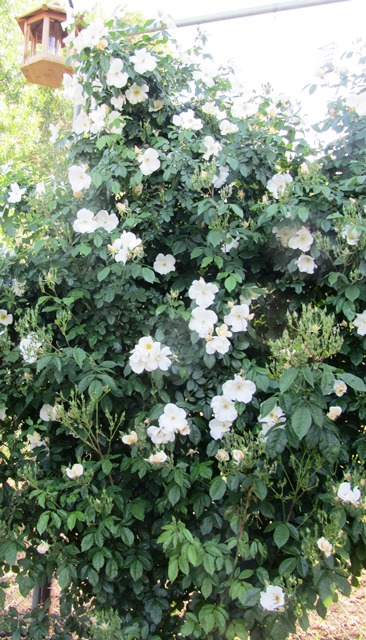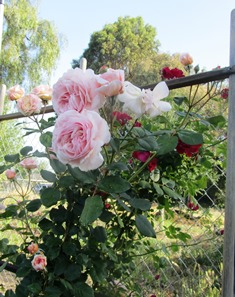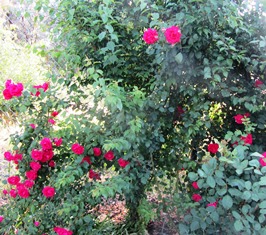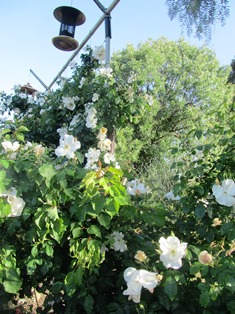Propagating Plants from Rose Cuttings
Roses are among the most romantic flowers in a garden. I grow dozens of cultivars of rose bushes–climbers, hybrid teas, floribundas, and polyanthas. When I have an extra few dollars, I might spend it on a rose bush, but when money is tight, I simply start a new bush from one of my favorites that I’m currently growing.
My husband and I love the climbers. We have tall fences (over six feet) around our property on all sides. Covering an entire fence is easy when you use a vigorous, virtually pest-free climber. Two roses that quickly adapt and grow to fantastic heights are Sally Holmes and Cecile Brunner.
Climbing roses need strong support, since some canes can reach forty feet or more as they scramble over a roof or stone wall, trellis, fence, or arbor.
Last year, my husband created a rose arbor on wires strung from the fence along the north side of our house to the roof line. He planted the Cecile Brunner rose as his climber of choice. Its sage green leaves make a lovely foil for the tiny pink roses that permeate the air with a spicy-sweet scent throughout the spring. Cutting and feeding will render another bloom in summer.
My garden has plenty of places where I could tuck in a new rose bush, and I’ve bought many over the years. I have some favorites that I’d like to start in other areas. They include A Shropshire Lad, Handel, Lady Banks (a thornless yellow rose), and Iceberg.
This is the perfect time to propagate roses from cuttings in the Bay Area since the rose bushes in many yards are beginning to awaken. Roses require water, something no longer plentiful in California. Thanks to a severe four-year drought, we now have mandatory water restrictions. That means we gardeners must consider how we can recycle water, use gray water, collect water, and otherwise find ways to reduce water usage.
To propagate a rose from your favorite bush, take a six-inch cutting from a healthy cane. Make the bottom cut a sharp angle cut, not straight across. Do not crush the stem. Remove the leaves.
Dip the angle cut into a jar of root hormone powder. This powder enables the cane to root more easily in the ground or pot.
Insert the prepared cutting in the soil. Water as needed when the soil is dry. The cutting will need one to two months to root and then, it will begin to leaf out.
Some people like to put a quart jar over their cutting to create a mini-green house climate. In mild climates like the Bay Area, this isn’t necessary. The best time to propagate cuttings from your favorite roses is in the spring and never in extremes of cold or heat.
Creating romance in the garden could start with a table and chairs, floral-motif linens, and a service of tea. But even before those accoutrements to romance are added, why not fill the space with roses? It’s so easy.
Climbing Roses Put On a Show for Spring
I confess I’m a rose lover. This time of year, the climbing roses we’ve planted are clambering up on wooden trellises, chain link fences, and even the wall of the chicken house, putting on a spectacular display. What’s not to love?
Here in Northern California’s inland valleys, these climbers offer their most magnificent displays of color, shape, texture, and scent during spring. Most do well with a season-long balanced fertilizer, water, and pruning to remove dead canes and spent flower heads. Mulch with organic matter to conserve water and keep down the weeds.
Climbing Handel features cream-colored blooms, edged in a rose shade of pink. It is hardy, has glossy green foliage, and upright pillar growth.
Climbing Don Juan grows upright and has a tendency to spread out. Its canes produce red flowers that are 3 to 6 inches in diameter. The plant blooms from spring until frost.
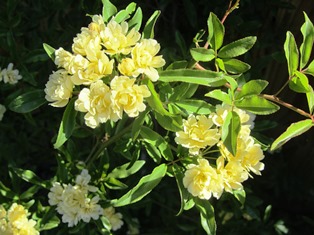
Lady Banks is a species rose named after the wife of Sir Joseph Banks, legendary head of the Royal Horticultural Society of Great Britain
Climbing Lady Banks scampers up our chicken house wall and explodes into a profusion of hundreds of disease-resistant yellow roses on long canes without thorns. This rose is not a hybrid, but rather comes from China and has been cultivated since 1796. To say it spreads is an understatement–the largest Lady Banks grows in Tombstone, Arizona where it covers 8,000 square feet.
Climbing Sally Holmes is a showoff in our garden. The pointed-shaped buds start out cream-colored (tinged in pink) and then open into an white bloom with a light, sweet fragrance. The rose can climb 12 feet, the height ours has reached where it grows along the back fence.
The vigor of Sally Holmes means it can easily be grown from cuttings. In fact our massive climber was grown from an arm-length cutting dusted with root hormone that we stuck in the ground three years ago. We’ve taken many cuttings since to start the climber elsewhere on our property.
If you have the space for climbers, consider giving one or more a try. Although they are hardy, often disease-resistant, and reward with spectacular displays of bloom, they need support, so think pillars, arbors, gazebos, porch railings, and fences.
 Facebook
Facebook Goodreads
Goodreads LinkedIn
LinkedIn Meera Lester
Meera Lester Twitter
Twitter



